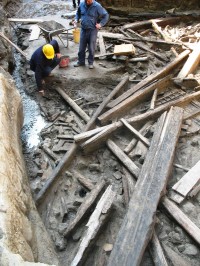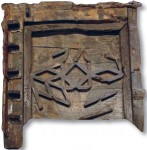 In 2010, workers from the Herculaneum Conservation Project were struggling as they so often do with drainage issues. The crux of the issue is that water in the modern city flows down to what used to be the beach, only Vesuvius saw to it that the shore was pushed hundreds of feet into the sea; so the area of the ancient city that used to be prime beach real estate is constantly and dangerously waterlogged.
In 2010, workers from the Herculaneum Conservation Project were struggling as they so often do with drainage issues. The crux of the issue is that water in the modern city flows down to what used to be the beach, only Vesuvius saw to it that the shore was pushed hundreds of feet into the sea; so the area of the ancient city that used to be prime beach real estate is constantly and dangerously waterlogged.
They decided to install some new drainage pipes on the site. Since they’d have to jackhammer their way through at least three feet of hard volcanic rock in order to lay the new pipe, the archaeologists did an initial survey to be sure nothing ancient and man-made would be damaged. They didn’t expect to find anything — the Roman beach had been thoroughly excavated in the 1980s — but in a section that hadn’t been explored, they not only found something: they found an entire ancient Roman wooden and tile roof.
 Preserved by the volcanic rock on one side and the black sand of the beach on the other were massive wooden beams as much as 23 feet long, smaller joists and rafters, decorative panels and terracotta tiles. The tiles were underneath the timbers. They would originally have been the top layer of the roof, which means that the entire structure was ripped off the house, flipped upside down and deposited on the beach by the force of the pyroclastic surge. Unlike many of the other preserved organic materials found in Herculaneum, the timbers were not carbonized. They were smashed into wet sand, then kept safe by subsequent pyroclastic flows that hardened into layers of air-tight rock.
Preserved by the volcanic rock on one side and the black sand of the beach on the other were massive wooden beams as much as 23 feet long, smaller joists and rafters, decorative panels and terracotta tiles. The tiles were underneath the timbers. They would originally have been the top layer of the roof, which means that the entire structure was ripped off the house, flipped upside down and deposited on the beach by the force of the pyroclastic surge. Unlike many of the other preserved organic materials found in Herculaneum, the timbers were not carbonized. They were smashed into wet sand, then kept safe by subsequent pyroclastic flows that hardened into layers of air-tight rock.
The wood roof was in such exceptional condition that carpentry marks and joints were clearly visible. They bore glorious testament to Roman carpentry, because even with all those massive timbers and rafters, there isn’t a single nail in the entire structure. There were a few cramp irons employed, but other than that, the structure was supported with joinery, trusses and its own pitch.
 Archaeologists calculated from its location that the roof must have once topped the Marble Room in the House of the Telephus Relief, one of the largest and richest houses in Herculaneum, probably owned by Marcus Nonius Balbus, praetor, proconsul and patron of the city. Statues and inscriptions dedicated to him litter the entire town, and the house has a private entrance to the baths, donated by Balbus to the city. The house got its name because a marble relief was found in the living room depicting Telephus, the king of Mysia and the son of Hercules who was wounded by Achilles in battle.
Archaeologists calculated from its location that the roof must have once topped the Marble Room in the House of the Telephus Relief, one of the largest and richest houses in Herculaneum, probably owned by Marcus Nonius Balbus, praetor, proconsul and patron of the city. Statues and inscriptions dedicated to him litter the entire town, and the house has a private entrance to the baths, donated by Balbus to the city. The house got its name because a marble relief was found in the living room depicting Telephus, the king of Mysia and the son of Hercules who was wounded by Achilles in battle.  The relief shows Achilles with his mother Tethis on the left, and on the right Achilles scraping the spear that hurt Telephus into the wound in order to heal it, as per the advice of the Delphic Oracle.
The relief shows Achilles with his mother Tethis on the left, and on the right Achilles scraping the spear that hurt Telephus into the wound in order to heal it, as per the advice of the Delphic Oracle.
Once the wood parts and tiles were fully excavated last year, archaeologists had 250 pieces to work with, so they decided to do something that hasn’t been done before: puzzle together an entire original Roman timber and tile roof. They were able to put tab A into slot B, determining the angle of the pitch from the joinery alone.
Woodwork panels that once decorated the ceiling also survived, some of them with traces of their original paint and gold leaf. They can tell that it was immensely colorful, even garish by today’s standards. The team is currently working on piecing together the ceiling pattern, which they think matched the colorful marble pattern of the floor.
The ceiling panels and roof are being kept in a refrigerated container for their preservation. The Herculaneum Conservation Project plans to send the roof to the British Museum for its massive Pompeii and Herculaneum exhibit in March of 2013. The idea is to put the whole thing together inside the exhibit gallery, but transportation of such delicate ancient organic artifacts is tricky, so we’ll see. If all goes as planned, the roof will make its public debut very far from home in London.